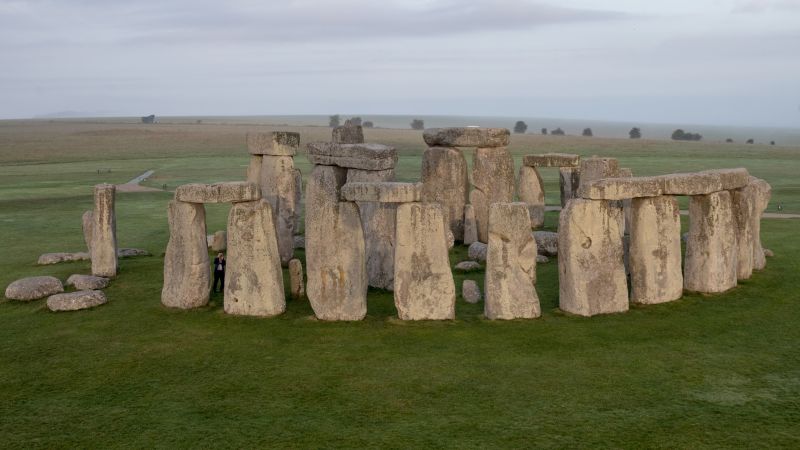Stonehenge, a legendary site situated on the southern edge of England’s Salisbury Plain, continues to captivate the imagination of archaeologists and history enthusiasts alike. Recent scientific discoveries have further illuminated the significance of this prehistoric monument. In August of this year, researchers presented compelling evidence suggesting that the Altar Stone—one of Stonehenge’s most iconic monoliths—was transported over 400 miles from what is now northeastern Scotland. Dating back nearly 5,000 years, this new understanding sheds light on the complex relationships between ancient communities and their movements across the British Isles.
A key focus of the research revolves around the challenges of determining the stone’s origins. Initial suspicions about the Altar Stone’s provenance pointed to Orkney, a group of islands off Scotland’s northeastern coast known for its Neolithic sites. However, researchers concluded that this region could not be the source. They continued their investigation, leading to a deeper exploration of how this heavy, 13,227-pound (6 metric ton) monolith was moved from its original location to Stonehenge. This inquiry is part of a broader effort to understand the reasons behind the construction of Stonehenge and its role in unifying ancient Britons amidst a wave of new arrivals from the European continent.
Emerging from this research is a fascinating hypothesis that suggests Stonehenge was reconstructed between 2620 and 2480 BC, following the arrival of new populations. This has been documented in a recent study published in the journal Archaeology International, which points to strong connections between ancient communities in Scotland and those in southern England, far surpassing previous assumptions of isolation. The architectural similarities between various stone circles and the unique alignment of the monoliths within Stonehenge reveal that this site was likely a focal point for cultural exchange and interaction.
Professor Mike Parker Pearson, the lead author of the study from the Institute of Archaeology at University College London, expressed the revised understanding of Stonehenge’s importance. He noted that the monument was significant not just for its immediate community but also for people across the entirety of Britain, highlighting its role as a unifying site. The method of transportation and assembly of the stones involved extensive collaboration, marking a remarkable feat of engineering and organization for Neolithic peoples.
Stonehenge’s construction began around 3000 BC, with distinct phases of development throughout its history. Researchers uncovered that different types of stone, including the iconic bluestones from the Preseli Hills in Wales, were employed in its construction. The Altar Stone itself likely had a central role during a rebuilding phase between 2500 and 2020 BC, where other monumental components including large sarsen stones were positioned to form a complex arrangement that aligned with celestial events.
The precise alignment and positioning of the stones, particularly with respect to the sun during solstices, suggest that Stonehenge served as a temple or a celestial observatory. This aligns with the view that it was also a burial ground, as a significant number of individuals interred nearby came from regions outside of Salisbury Plain, indicating that Stonehenge’s influence extended widely.
In addition to its spiritual significance, there is a political dimension inherent in the reconstruction of Stonehenge. The movement of stones from great distances indicates a collective effort, likely aimed at forging a new identity among disparate groups at a time when significant population shifts occurred. The newcomers brought with them knowledge of metallurgy and agriculture, further intertwining the diverse communities forging their paths in early Britain.
The logistics involved in transporting massive stones also highlight the innovation of that era. Researchers propose that the Altar Stone was maneuvered across land using wooden sledges, suggesting sophisticated methods for overcoming physical challenges. As the study posits, moving such a colossal object would likely have required thousands of participants, allowing for a spectacle that drew communities together.
Despite the collaborative efforts symbolized by the act of transporting the Altar Stone, the findings reveal a more profound narrative of cultural transformation. Following the influx of new arrivals, the genetic make-up of the population shifted dramatically, leading to a landscape where the Beaker people became the dominant population.
In closing, while Stonehenge remains shrouded in mystery, the recent studies have significantly enhanced our understanding of its role as a monumental space of unity, complex interactions, and cultural exchange in ancient Britain. Ongoing geological research aims to uncover the Altar Stone’s exact origins, as academic interest and discoveries continue to unveil the layers of history surrounding Stonehenge—an enduring symbol of human ingenuity, collaboration, and the quest for connection throughout millennia.



